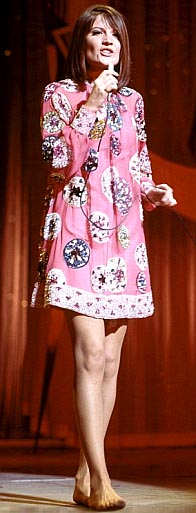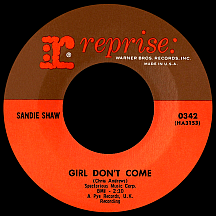SANDIE SHAW
Girl Don't Come
"The Barefoot Pop Princess" is the nickname on which Sandie Shaw built her public image, one that, when exposed at the outset of her career, made video broadcast close-ups of her tootsies and full-height photographs a prerequisite since she was, after all, as much an icon of style as an interpreter of cleverly-crafted pop tunes in Great Britain during the mid-1960s. In the U.S.A., on the other hand, she had a less perceptible image, that of a mostly-unseen, sympathetic voice below an isolated street lamp or outside a small cafe, detailing the pitfalls of emotional anguish as a clock nearby chimes nine times. Sandie emerged in late '64 and faded away the following summer, back into the night mist, having generated little or no visual impression, thus voiding any need to manicure toenails or be concerned about the length of her bob cut or stitch of her loose-fitting minidress (not that it concerned her much), leaving stateside fans with but a sonic memory. Oh, but there was so much more to her!
Born Sandra Goodrich in Dagenham, east end of London, she was working in the office at the area's massive Ford auto factory in 1963, long-haired at age 16 with limited experience as a model, having her strands trimmed at the suggestion of a photographer to the Vidal Sassoon-style 'do that was all the rage. In 1964 she approached members of The Roulettes, the backing band for one of the top-selling singers in the isles, Adam Faith, at a show they were doing. Not yet certain whether she preferred singing or posing for the camera, or both, only knowing she had to get out of that assembly-line atmosphere, she impressed Adam enough that he suggested her to his manager, Eve Taylor, and before long Sandie was signed to Pye Records (not the same label as Faith), making her first recordings in her bare feet (seems she somehow sang better without shoes).
Essex-born songwriter Chris Andrews, who'd penned a couple of Faith's hits (one of which, "We Are in Love," was arranged like a Beatles record, imitation being a calling card for the singer since his first Buddy Holly-like hits in '59), supplied material for Miss Goodrich, who would soon be using the stage name Shaw (they at least let her pick the "ie" spelling of her first name). Her vocals on "As Long as You're Happy, Baby" (licensed to Mercury Records in the U.S. and issued minus the "Baby" in the title) came off shakily (perhaps the slippers should've stayed on) and the record stiffed on both sides of the pond. A better strategy was employed for the second single: Americans Burt Bacharach and Hal David had penned Dionne Warwick's hit "Anyone Who Had a Heart," successfully covered by Liverpudlian Cilla Black (all the way to number one in February '64). Producers suggested Bacharach and David's "(There's) Always Something There to Remind Me," which was hitting the U.S. charts by Lou Johnson at the time of Shaw's session. As it had for Cilla, the trick worked for Sandie, whose vocals on the song were more self-assured than on the first effort while retaining an appealing innocence; it hit number one in October. Reprise Records picked up the master in the States and it had a decent but unspectacular run, falling shy of the top 40 around the end of the year.
Sandie was photographed in the recording studio sans shoes and the pic got published. Then, without planning to, she performed barefoot on ITV's Ready Steady Go! (she "slipped her shoes off" but they went missing when it was time to go on). Inadvertently it worked in her favor...a public image had been established. In a reversal of logic, she henceforth had to appear barefoot for fear people might think she was "odd." The public had no such impression; Sandie was a star. Rerecording her hits in French and German for wider coverage, she also designed her own clothes and was attached to the "Mod" trend of the time.

The follow-up single, Andrews' "Girl Don't Come," peaked at number three in England at the beginning of 1965, then became her best-known song in the U.S., a bit curious considering its arrangement is nearly identical to "Always Something There." But something about it clicked, the lyrics and Sandie's sweet-voiced performance hitting the right degree of desperation for the song's male subject: 'You wanna see her, oh yeah...so you wait, you wait and wait...girl don't come...you've been stood up, tears fill your eyes oh, wo-oh...you hurt inside, you wanna die...' Ay, yi, yi! Still not a runaway smash, it made it into the Cash Box top 40 for one week in April '65. Yet the haunting arrangement and Shaw's singing sticks with anyone who's ever heard it.
Successive Andrews tunes strengthened Sandie's star power. The assertive "I'll Stop at Nothing" went top ten U.K. early in the year and "Long Live Love," a bouncier Chris Andrews tune, sailed to number one in May, the latter released as a follow-up to "Girl" in the U.S., though it barely dented the national survey in early summer; "I'll Stop" seemed an afterthought as it became the next single and quickly disappeared. Chris Andrews' singing career kicked in around that time; "Yesterday Man" was a top ten U.K. hit in the fall and a minor U.S. charter in January '66 and he enjoyed four more hits at home, as singer and songwriter, over the next year. "Message Understood" and several other Andrews compositions took Sandie through late '66, though the sameness of the arrangements took their toll on chart performance (one exception, "Run," had a larger-orchestra vibe that failed to alter the downward slide). In America, she was all but forgotten by this time. In Europe, she was about to rise to a new level of stardom.
Execs at the BBC chose her to represent Britain in the Eurovision Contest, its 12th go-round to be held in Vienna, Austria in April. "Puppet on a String," a song written by Scotsman Bill Martin and Irishman Phil Coulter, was the song foisted upon her. Sandie had never been a fan of Eurovision with all its gaudy glitz and absolutely detested the song, its circusy oom-pah-pah arrangement destined to be a pain in her neck forevermore. But she couldn't get out if it, as it was widely considered an honor throughout Europe to be a participant in the high-profile, goodwill-among-nations event. It almost didn't happen, though; the not-so-innocent-after-all singing star, just turned 20, was named in the divorce case of model Veronica Sands and her husband, former Ready Steady Go! program assistant and unapologetic womanizer Douglas Murdoch, with whom Sandie had been adulterously linked. The BBC nearly dropped her from the competition, but the show went on with her in it, performing "Puppet" barefoot...and she took first place! The record, which had already begun climbing the British charts, hit number one a couple of weeks later and went on to sell millions throughout Europe and much of the world. This song she felt was "horrible," and said so many times, ended up being her biggest hit! Go figure!
In her homeland, at least as far as singing and selling records, Sandie enjoyed a nice spike in the two years following her Eurovision win and scandal rag headlines (which, let's face it, usually help more than hinder) with several hits including "You've Not Changed" and "Monsieur Dupont." And young women continued looking up to her as a stylish role model for quite some time. She left Pye Records in 1972, later trying her hand at acting in William Shakespeare's Hamlet and other stage presentations. Her marriage to fashion designer Jeff Banks ended, finances dwindled due to her investment in his failed company, and it took several years to get back on track.
She made records with The Smiths in the mid-'80s (and performed barefoot with the band's leader, Morrissey); they backed her on "Hand in Glove," a rocking 1984 U.K. hit, her first in 15 years. Later, she embarked on an entirely different career as a psychotherapist. Throughout the years, while Sandie Shaw's life wove its way through scandalous headlines, the unexpected Eurovision triumph, failed marriages, a music biz comeback, and so much more for fans in her native land to keep track of, practically everyone in the States, save the most devoted celeb-watchers, remained unaware. To most of us, she's the "Girl Don't Come" girl, one of the more memorable singers from the British Invasion of the mid-'60s.


